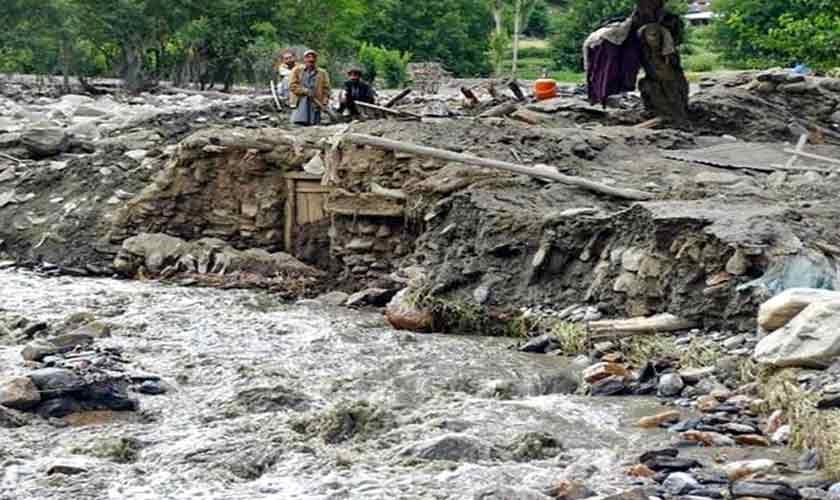
#KPs #monsoon #myopia #Political #Economy
On June 27 and 28, Rajdi was once again targeted in the Swat Valley. Fizagat and Khoz Khela once saw the devastating destruction as a massive flash flood, which was encouraged by the monsoon shower, which washed tourists, families and livestock along the Swat River.
Videos circulating on social media have shown that more than a dozen people, including children, are leaning on a piece of water surrounded by water. When the rescue operation could be launched, eleven people lost their lives.
According to a preliminary report by the Provincial Disaster Management Authority, there were four children and three women who were killed. Reports say that three people are still missing. Elsewhere, 59 people were rescued in the frank operations carried out by Rescue 1122. Local sources damaged 56 houses, six of which were completely destroyed. Flash floods in Punjab also killed 13 people.
Although the National Disaster Management Authority had already issued alerts, the river was accessible to tourists. Despite similar damage in 2010, 2020 and 2022, several hotels and restaurants were standing in illegal proximity from the river along the river. The government then marked the ‘Red Zone’ and promised severe implementation.
The recurrence of tragedy due to the large -scale flash floods is a symbol of a major crisis that makes every monsoon. Every year, officials respond to Monsoon as they are surprised. Every year, rescue work is delayed. Every year, some officials are suspended from the service and long -term inquiries are ordered to hide a dangerous cultural phenomenon to apparently failure of governance, absence of planning and forget.
When the rain looted
Every year, witnessing the plains, hills and valleys of Khyber Pakhtunkhwa, western devastation causes widespread devastation as flood water eliminates everything in their path. To schools, homes, roads and people. These devastating events repeat every year with tragic forecasts. This raises the question: What has Khyber Pakhtunkhwa learned from its long history of monsoon destruction? Although some steps have been taken to strengthen the reaction system, active measures to reduce monsoon risks are largely absent.
According to the Provincial Disaster Management Authority, more than 100,000 houses were completely destroyed in the flood of 2022 and killed more than 289 people. Thousands of acres of fields were eliminated in Swat, Tanks, Charsada and Dera Ismail Khan districts, including NDMA damage diagnosis as one of the most destructive years in KP history to 2022. Most of the promised reconstruction, reforms and regulations are on paper.
Rescue 1122 has improved in parts of Swat and Peshawar. Public awareness campaigns, especially local mosques and radio, have taught locals in the method of evacuation. However, such campaigns lack long -term benefits as they depend on donor financing. This is limited to their access and stability.
After the 2010 flood, the Planning Commission had recommended transfer to communities living within the active rivers of Swat and Kohistan. However, in 2022 many villages were washed. Despite the ongoing warnings as a result of the 2022 floods, effective anti -encroachment drives did not follow it. Satellite -based flood plane studies through the Swiss Humanitarian Aid Unit (SHA/SDC) in 2022 have shown that many damaged commercial buildings and houses made in the river buffer zone are a violation of environmental safety standards. The violation continued in 2024 and once again in 2025. Local authorities often blame the landlords and the absence of political assistance. The reasons are painful. Residents are often poor farmers and laborers who build their homes at the same places due to lack of alternative lands for houses and security. To date, no meaningful migration policy has been implemented.
The prevention becomes silent
One of these few areas where KP has shown progress is the initial warning system. A strong flood alert system has been developed, in collaboration with the NDMA, PDMA and the Pakistan Meteorological Department. In 2023, text messages were sent to people living in the flood -hit districts of Swat and Kohistan. Provincial disaster reaction forces were on high alert and boats and tents were already in seven districts. However, preventing, weakening, instead of reaction.
KP lacks river monitoring system. Authorities rely on rain forecast. In comparison, there is a real -time telemetry on Indus assistants in Punjab. Rivers of KP Flash like Panjkura and Swat still lack advanced river gauges. As a result, when washed 30 houses in mid -2023 soil of mid -July, the NDMA repeatedly warned that these areas need hydroological sensors.
Such tragedies will continue again until policy makers in Peshawar have preferred the development of proper drainage networks, flexible schools and flood infrastructure.
One of the major challenges is the ongoing river banks and on the flood fields. The NDMA’s monsoon emergency project was declared in 2023 in the North KP districts – Swat, Kohistan, Manrah and Dir – the victims of the flood. Despite judicial orders and government rules and regulations, prohibited construction on the banks of the Swat River continues. It tightens the channel, which increases the strength and destruction of the flood water. In the 2022 floods, houses and hotels located in Bahrain and Kalam were completely washed away by high -speed floods. The citizen unit reported that about 40 percent of the houses destroyed in the upper Swat were built within 50 meters of the river, in violation of the security guidelines.
The weakness of the infrastructure is another problem. The Swarts built after the flood in 2023 in 2023 and the bridges were once again damaged, which revealed poor engineering. The temporary backs built in 2023 were washed with floods in 2024. Locals often accuse contractors of using non -standard content and leave the projects incomplete. Contractors accuse timely financial support.
Urban drainage is another problem. Even moderate rains are submerged for parts of Peshawar for the day. The city’s storm is often strangled by plastic waste of water drains. Despite the allocation of the budget, many water drainage projects have not been countered with the storm in Faqirabad, Tahkal and Hayatabad.
The maintenance path
A success story in Nepal and Bangladesh has been almost absent community -based floods. In remote districts like the upper late, the elders rely on the traditional knowledge and the noise of the river, such as a sudden change in animal behavior and a sudden change in temperature. Indigenous skills are often in the sideline in favor of advance models that fail to calculate the ground truth.
GLOOF
The hill districts of the province – Kohistan and Upper Chitral – lack a complete and dedicated glove alert system. Although the Federal Government’s GLOF-II project, which is mainly focused on Gilgit Baltistan, covers parts of KP, its access is minimal.
There is no shortage of warnings in KP. In 2018, the NDMA and Superco warned the icy melting and sharp glphs in the northern parts of the province. The Disaster Risk Management Center of the University of Peshawar has published an investigation that has requested maximum investment in the location harvesting and slopes.
Lack of climate adaptation plans to raise problems. Unlike Punjab and Sindh, where climate adaptation projects have been prepared, KP has not prepared a roadmap for climate reconciliation. A recent study by climate analytics and the International Center for Integrated Mountain Development says the upper late and Chitral districts are the weakest in the Himalayan belt. With the expectation of flash floods and glofings to be more common in future years, the entire communities are at risk.
School and hospital
A surprise 1,180 schools were completely destroyed in the flood of 2022, a report submitted to the National Assembly in 2023, the Department of Education said. By 2024, only 430 of them were rebuilt or repaired. According to Alif Eilan’s educational infrastructure audit, Swat and Dera Ismail Khan have the highest proportion of children going to flood -affected schools.
Another report compiled by the Department of Education states that 142 schools were damaged in 2024, especially in Upper Dear, Batagram and Swat. Many schools destroyed in 2022 are still awaiting repair. In many parts of the province, children continue to study in tents and open air places. The temporary learning centers established by UNICEF and local NGOs have filled the gap, but the absence of proper infrastructure affects the quality of education and the safety of children.
Medical preparations are also regrettable. In 2024, people from many villages in Kohistan and Swat districts reported skin infections, diarrhea and snake bites after the flood. Mobile health teams arrived late and the basic health unit (BHU) lacks the necessary medicines. The NDMA’s 2024 directives suggested the advance positioning of medical equipment, but district health officials often complained of funds that arrive very late.
A cycle of being disabled
According to a joint report by the Asian Development Bank and UNDP in 2023, the budget for flood flexibility in KP is 0.5 % of the annual development project, which is insufficient to meet the basic infrastructure upgrade. Despite the availability of donor funds, international technical support, implementing the region is unusual. A monitoring report by the Asian Development Bank in 2024 says that KP has other low use rates for flood projects in the provinces.
Federal agencies have permanently warned that the climate change will intensify and the monsoon rains will increase over the years. Unfortunately, KP has yet to learn its lessons.
The price of this dishonesty is very disturbing in the long run. Economically, trillions of rupees are wasted annually in precious lives, homes, livestock and crops. Psychologically, confidence in state institutions is lost. Society, many generations of children have lost their education. Environmental, each flood eliminates soil, eliminates forest cover and increases future disasters to a great extent.
Flooding policies in KP are largely unheard of. Residents also talked about rescue helicopters arriving after washing people. Unless policy makers in Peshawar have given preference to proper drainage networks, flexible schools, urban planning policies and flood infrastructure, tragedies like the Swat River will continue.
Zeeshan Nasir is a tribet -based writer who is currently holding an MBBS degree in Makran Medical Class, Turbat. He tweeted on X @Zeeshannasir972.






